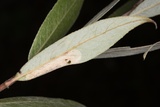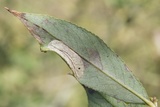Phyllonorycter salictella (Zeller, 1846) Species
Last modified: Dec. 14, 2024, 4:35 p.m.
A widespread but not very common species.
Details
- Classification
- Family: Gracillariidae > Subfamily: Lithocolletinae > Genus: Phyllonorycter > Species: Phyllonorycter salictella
- Vernacular names
- Witstreepwilgenvouwmot (NL), Korbweiden-Faltenminiermotte (DE)
- Synonyms
- Phyllonorycter viminiella (Sircom, 1848)
- First mention in Belgium
- De Fré Ch. 1858. Catalogue des Microlépidoptères de la Belgique. — Annales de la Société entomologique belge 2: 45–162. On page 156 (as L.[ithocolletis] Salictella. Zell.). view page
- Status
-
Native
Distribution
Imago
Head brown, with some mixed white scales; forewing ground colour rather dark brown; white, sometimes yellowish white, pattern consisting of a basal line, not edged; a narrow, but mostly long patch at the dorsum near the base, sometimes connected to the first dorsal stria; four costal and three dorsal striae, the first dorsal stria is the longest.
Museum specimens
No pictures yet!Specimens in nature
No pictures yet!Mine
A rather large, elongated tentiform mine on the underside of a leaf, frequently close to the leaf margin and the leaf basis. The mine is parallel to the leaf margin and has one or more central longitudinal folds. In later stages, the mine is strongly contorted and the leaf margin may be covering the entire mine. The black frass is concentrated in a corner of the mine.
See also gracillariidae.net and bladmineerders.be.
Cocoon/pupa
A tough light brown cocoon in which no frass is present.
Bionomics
The species hibernates in the pupal stage. After the emergence of the adult, the pupal skin protrudes from the mine.
Flight periods
Two generations a year from the end of April till the beginning of June and in August.
Observed on
- Host plant (species):
- Salix alba
- Host plant (genera):
- Salix
The species lives on various, long-leaved species of Salix, with a preference for Salix alba, but it has also been recorded on other species, like S. daphnoides, S. fragilis, S. incana, S. purpuralis and S. viminalis.


